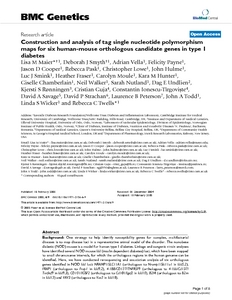Maier, LM;
Smyth, DJ;
Vella, A;
Payne, F;
Cooper, JD;
Pask, R;
Lowe, C;
Hulme, J;
Smink, LJ;
Fraser, H;
et al.
Maier, LM; Smyth, DJ; Vella, A; Payne, F; Cooper, JD; Pask, R; Lowe, C; Hulme, J; Smink, LJ; Fraser, H; Moule, C; Hunter, KM; Chamberlain, G; Walker, N; Nutland, S; Undlien, DE; Rønningen, KS; Guja, C; Ionescu-Tîrgoviste, C; Savage, DA; Strachan, DP; Peterson, LB; Todd, JA; Wicker, LS; Twells, RC
(2005)
Construction and analysis of tag single nucleotide polymorphism maps for six human-mouse orthologous candidate genes in type I diabetes.
BMC GENETICS, 6 (9).
ISSN 1471-2156
https://doi.org/10.1186/1471-2156-6-9
SGUL Authors: Strachan, David Peter
![[img]](https://openaccess.sgul.ac.uk/434/1.hassmallThumbnailVersion/1471-2156-6-9.pdf)  Preview |
|
["document_typename_application/pdf; charset=binary" not defined]
Published Version
Download (309kB)
| Preview
|
Abstract
BACKGROUND: One strategy to help identify susceptibility genes for complex, multifactorial diseases is to map disease loci in a representative animal model of the disorder. The nonobese diabetic (NOD) mouse is a model for human type 1 diabetes. Linkage and congenic strain analyses have identified several NOD mouse Idd (insulin dependent diabetes) loci, which have been mapped to small chromosome intervals, for which the orthologous regions in the human genome can be identified. Here, we have conducted re-sequencing and association analysis of six orthologous genes identified in NOD Idd loci: NRAMP1/SLC11A1 (orthologous to Nramp1/Slc11a1 in Idd5.2), FRAP1 (orthologous to Frap1 in Idd9.2), 4-1BB/CD137/TNFRSF9 (orthologous to 4-1bb/Cd137/Tnrfrsf9 in Idd9.3), CD101/IGSF2 (orthologous to Cd101/Igsf2 in Idd10), B2M (orthologous to B2m in Idd13) and VAV3 (orthologous to Vav3 in Idd18).
RESULTS: Re-sequencing of a total of 110 kb of DNA from 32 or 96 type 1 diabetes cases yielded 220 single nucleotide polymorphisms (SNPs). Sixty-five SNPs, including 54 informative tag SNPs, and a microsatellite were selected and genotyped in up to 1,632 type 1 diabetes families and 1,709 cases and 1,829 controls.
CONCLUSION: None of the candidate regions showed evidence of association with type 1 diabetes (P values > 0.2), indicating that common variation in these key candidate genes does not play a major role in type 1 diabetes susceptibility in the European ancestry populations studied.
| Item Type: |
Article
|
| Additional Information: |
PubMed ID: 15720714
© 2005 Maier et al; licensee BioMed Central Ltd.
This is an Open Access article distributed under the terms of the Creative Commons Attribution License (http://creativecommons.org/licenses/by/2.0), which permits unrestricted use, distribution, and reproduction in any medium, provided the original work is properly cited. |
| Keywords: |
Science & Technology, Life Sciences & Biomedicine, Genetics & Heredity, HUMAN NRAMP1 GENE, SUSCEPTIBILITY GENE, BB RAT, AUTOIMMUNE, IDENTIFICATION, MELLITUS, DISEASE, MICE, ASSOCIATION, LINKAGE, Animals, Case-Control Studies, Chromosome Mapping, Diabetes Mellitus, Type 1, European Continental Ancestry Group, Family Health, Genetic Predisposition to Disease, Genotype, Humans, Mice, Mice, Inbred NOD, Open Reading Frames, Polymorphism, Genetic, Polymorphism, Single Nucleotide, Sequence Analysis, DNA, Untranslated Regions |
| SGUL Research Institute / Research Centre: |
Academic Structure > Population Health Research Institute (INPH) |
| Journal or Publication Title: |
BMC GENETICS |
| ISSN: |
1471-2156 |
| Related URLs: |
|
| Dates: |
| Date | Event |
|---|
| 18 February 2005 | Published |
|
| Web of Science ID: |
WOS:000227558900001 |
  |
Download EPMC Full text (PDF)
|
 |
Download EPMC Full text (HTML)
|
| URI: |
https://openaccess.sgul.ac.uk/id/eprint/434 |
| Publisher's version: |
https://doi.org/10.1186/1471-2156-6-9 |
Statistics
Item downloaded times since 30 Apr 2012.
Actions (login required)
 |
Edit Item |



